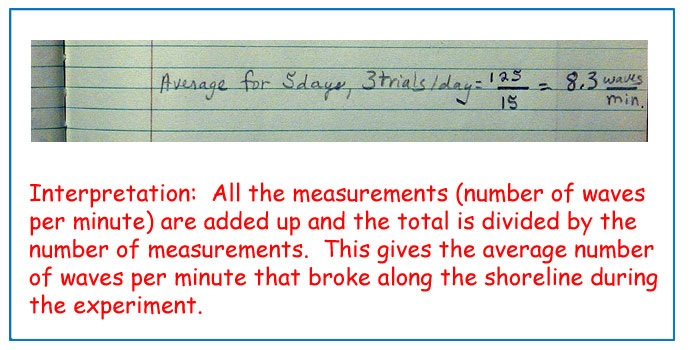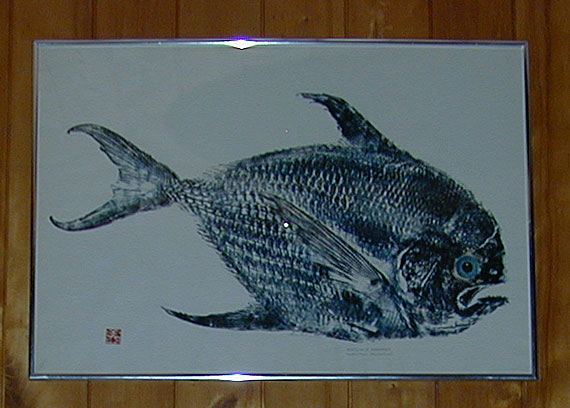
 |
| 1.1.2 |
| Over hundreds of years the scientific method became an accepted way for scientists to think about problems and try to solve them. All fields of science use these principles. Scientists believe that events don't just happen for no apparent reason. They believe that most things can be explained by a set of laws and principles. The scientific method is the way these laws and principles have been developed. It can be divided up into five steps - stating the problem, forming a hypothesis, experimentation and observation to obtain data, interpretation of data, drawing conclusions. |
 |
Leadbetter Beach, across the street from SBCC, where you might ask the question about how many waves strike the beach every minute during the summer. (GA image) |
| Stating the problem is like asking a question. Everywhere you go there are questions that can be asked and many people are interested in finding the answers to things like why the sky is blue, why the ocean is blue or green or brown or red, why certain fish may be poisonous and so on. Sometimes the answers can be found in a book because someone else asked the question and followed through with the scientific method and published their results. But, sometimes the answer is unknown and this is where the scientists do their work. |
 |
The Hypothesis. |
| Forming a hypothesis is like making up what you think is the answer to the question. At this time you are not sure if this is the real answer but it is a plausible one. By following the scientific method you can determine if your hypothesis is correct or not. If it is not correct then you can form another hypothesis and test that one until you get (hopefully) a result that explains your original problem. But, sometimes the answers to our questions elude us for years and years (like the cure for the common cold). |
 (GA image) (GA image) |
The Experiment. |
| Experimentation and observation to obtain data must be part of testing the hypothesis. Careful experiments must be planned so that the data obtained is very clear. Part of this process often involves setting up a set of experiments called 'controls' to be sure about the outcome. For example, if one is testing the effect of a chemical on an organism there would be a set of organisms that would be treated in the exact same way as the test organisms except without the chemical - these controls then would help to be sure the outcomes were only from the chemical and not from some other source (like a change in temperature or light). The materials and methods used for this step are carefully recorded so that they could be repeated by another person in another place. The data obtained is also carefully recorded for use. |
 (GA image) (GA image) |
The Interpretation. |
| Interpretation of data is the step that sometimes is difficult. Some experiments turn out very clear and others are hard to explain. At this step scientists often design a new set of experiments to gather more data to help sort out what is happening. |
 |
The Conclusion. |
| Drawing conclusions is the final step in the scientific method. This involves looking at the interpretation of the data and deciding if the original question has been answered and if it can be stated for others. If it can be clearly stated, supported by interpretation and data, and the experiments can be repeated then most scientists write up their results and publish them. This adds to our knowledge base. These scientific publications always have the materials and methods clearly described, the data detailed, and the interpretation and conclusion stated. This way anyone should be able to repeat what was done and get similar results. For this reason scientific papers are highly regarded by all countries and a wonderful way that we humans have for exchanging information between ourselves. |
 |
Fish print hanging in the author's dining room. Art is something that is personal and the 'scientific method' does not apply to whether or not someone likes particular art objects. The author loves marine science so this fish print has special meaning especially because her husband made it. (GA image) |
| Some things do not lend themselves to science. These are things like art, emotions, morality, traditions, and various other cultural aspects. There is no place for the scientific method in defining what is beautiful in a painting, person, or culture. Science helps us to define and pass on a certain body of knowledge that is 'testable' and other fields of study help us to define ourselves and be happy. We are lucky in our culture to be able to express our feelings and opinions about all matters whether scientific or not. And scientists often use beautiful images to describe their subject especially in marine science where images of the ocean and the wonderful forms of life bring with them an aesthetic appeal along with the science. |
(Revised 13 July 2004) |